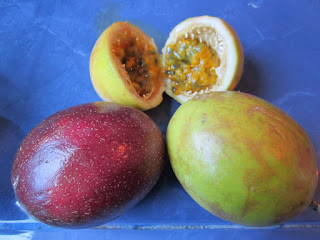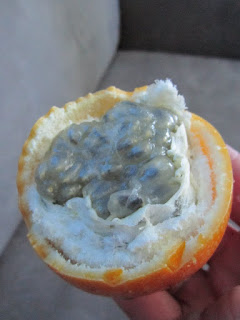Naranjilla (Solanum quitoense) - the Latin name for this fruit actually means "from Quito," prooving that this is definitely an Ecuadorian fruit. I actually couldn't find an English name for it (little orange??), but naranjilla, commonly used for juice here, has gone from a "what is this" fruit to one of my favorites! I'll take it as juice, icecream, a shake, whatever!
Tomate de Arbol (tamarillo) - another native of the region, this fruit is now cultivated as far away as Australia and New Zealand. Although tamarillo is often used for juice, it's great as a snack - just cut it in half and scoop out the center. Or you can cut a hole at the top and squeeze out the insides :). I've also heard that heating the fruit and eating it with honey has medicinal effects on a sore throat. I'm definitely trying that next time I'm sick!
Pitahaya (yellow dragonfruit) -think "sweet to the 10th power." I can't say this is my favorite fruit, even though I have a huge sweet tooth. However, every once in a while I like to cut a pitahaya open and scoop out the juicy flesh and seeds for an afternoon snack.
Uvilla (cape gooseberry or Inca berry) - the only time I've eaten fresh uvillas was when hiking with friend. We came across some growing wild and ate them along the way. However, my favorite Ecuadorian granola uses dried uvillas as a tangy addition to the mix. Native to the Andean mountain region, this fruit grows wild and isn't as common to find in a fruit market as the rest. In reality, it looks a lot like a small cherry tomato growing in a pod that refuses to take on any color other than orange.
Guanabana (soursop) - I've never had this fruit prepared in any other way than as a juice, so I'd call that standard fare for guanabana. However, when I was out on the coast a couple months ago, several people had soursop growing in their backyard, so here's the evidence:











